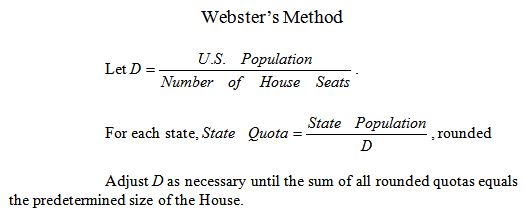- About MAA
- Membership
- MAA Publications
- Periodicals
- Blogs
- MAA Book Series
- MAA Press (an imprint of the AMS)
- MAA Notes
- MAA Reviews
- Mathematical Communication
- Information for Libraries
- Author Resources
- Advertise with MAA
- Meetings
- Competitions
- Programs
- Communities
- MAA Sections
- SIGMAA
- MAA Connect
- Students
- MAA Awards
- Awards Booklets
- Writing Awards
- Teaching Awards
- Service Awards
- Research Awards
- Lecture Awards
- Putnam Competition Individual and Team Winners
- D. E. Shaw Group AMC 8 Awards & Certificates
- Maryam Mirzakhani AMC 10 A Awards & Certificates
- Two Sigma AMC 10 B Awards & Certificates
- Jane Street AMC 12 A Awards & Certificates
- Akamai AMC 12 B Awards & Certificates
- High School Teachers
- News
You are here
Apportioning Representatives in the United States Congress - Webster's Method of Apportionment
This proposal also appeared to have no chance of passage in the Congress, so Senator Webster proposed yet another alternative:
It is remarkable that it was not until the 1830s that a serious proposal had been put forth suggesting the use of ordinary rounding. And because it is based on ordinary rounding, Webster’s method is, unlike several of the others, unbiased. A state’s quota has just as much chance of having a remainder at or above 0.5 as it does having one below 0.5. See the spreadsheet 1832 Webster for an illustration of his method. As before, you may download the file and try different values of the divisor “D” until the correct total number of House seats is achieved.
Finally, Representative James K. Polk of Tennessee, later the 11th President of the United States, threw another idea into the mix: let’s just go back to using Jefferson’s method and use a divisor of 48,000. After he and others investigated many other possible divisors, it was discovered that using 47,700 instead of 48,000 would cause the quotas of the states of Kentucky, Georgia, and New York to advance past the next whole number, thus giving these three states an extra Representative each. From a political point of view, the fact that those three states collectively held about one-fourth of the House seats at the time sealed the deal: Jefferson survived the flurry of proposals in 1832 and was again used to apportion the House.
For a side by side tabular comparison of the four proposed apportionments of 1832 , see the spreadsheet 1832 Comparison.
The steadily-growing discomfort with Jefferson’s method reached a peak in 1842, after the numbers from the 1840 Census had been finalized. After noticing the advantage gained by Kentucky, Georgia, and New York when the divisor was changed from 48,000 to 47,700, a mad search for divisors began in the Congress. More than 30 different divisors were proposed in the House within the range from about 50,000 to 62,000. Cooler heads in the Senate prevailed, however. The Senate proposed the first (and only, with a brief exception) reduction in the size of the House in history. Not only that, it proposed scrapping Jefferson’s method in favor of that of Webster. The proposal passed.
Webster’s time was short-lived, however. In the 1850s it was Hamilton’s method, the one vetoed by Washington, that was adopted. In fairness to Webster, the two methods did agree on the 1852 apportionment. But it should also be mentioned that Hamilton’s method was never strictly followed, often because of the continuing entrance of new states into the Union.
Michael J. Caulfield (Gannon University), "Apportioning Representatives in the United States Congress - Webster's Method of Apportionment," Convergence (November 2010), DOI:10.4169/loci003163





